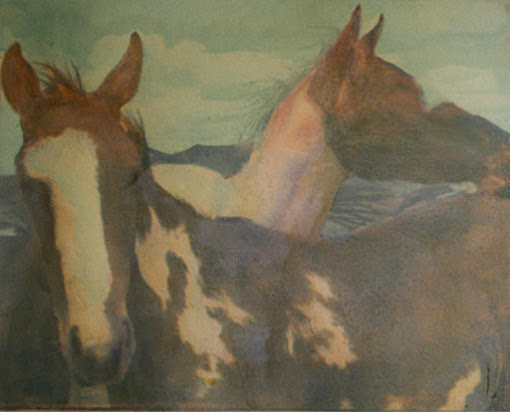The printing of the Civil War Reenactment images continues, as 8"x10" prints this time. All the 11"x14" prints of that portfolio have been destroyed before the reprinting began. The larger images began to soften and fall into the paper, enough so that they were becoming uninspiring. The smaller prints are much more visually inspiring, with more textured detail and sharpness. I was trying to stretch a 35mm film negative, scanned to digital, then prepared, same as now, was too much for some of the negatives; specifically, the original color images. That film was Kodak Gold, which was a very good film, with rich color saturation. Those colors, of course, get interpolated into panchromatic tonalities of grays before printing. All that can be worked through easily enough, but after thirty years, the film, not kept in a refrigerated state, becomes reticulated, leaving a visible 'bubbling' texture, and when that is stretched, well, it becomes crap.
These prints have been processed exactly as the larger printings. I am using two developers for this portfolio, as I'm not bound to uniformity as all matching images in a portfolio. I use the acetate cool toned developer for the images I feel are best represented with a richer warm-black image, and the citrate developer for a warm toned imaged underlying the palladium toning. The more nobler palladium salts replace all the silver salts of the print on the paper, leaving a fully palladium print image.
Palladium is considered a 'warm-toned' image, as the platinum print image is considered cool toned. Direct printing of the two prove this out, also depending on the platinum/palladium developer used. Potassium oxalate being the standard warm toned developer, with the ammonia oxalate being a cool toned developer, at lower temperatures. Heated to 95 degs, ammonium oxalate is very warmed toned, to the point of looking very similar to a Van Dyke brown print. When toning a silver print, the palladium toner opens up middle tones, deepens blacks and brightens highlights and whites. A thirty-second extra print time, in my UV printer anyway, compensates for this.
The silver prints developed in sodium acetate, are straight up 'black & white' images, and if toned in the gold toner using thiourea, the prints takes on the characteristics of a platinum print, with the primary difference in the middle tones, a straight gray tone with the silver and a more steely blue-gray mid-tones with platinum. When that same silver print ]acetate developed] toned in palladium, takes on the look of a palladium print, printed in palladium, developed in potassium oxalate. When the silver print, developed in the sodium citrate developer, and toned in palladium, leaving the print will less visual blacks, with more warm-toned blacks, softer, leaving the print more like the palladium print developed in the warmed ammonium oxalate.
This print was developed in sodium acetate, toned in palladium. 9-min print time and 9-min in the toning bath. The negative is somewhere between Log .8 and Log .9, printed in my UV printing box, at 160W of eight 24"white blacklight tubes, 6-inches from table top. This image, when compared to the 11"x14" version is much more visually pleasing, with a lot more textural detail, and tonal separation.
Palladium toned Kallitype
"The Cannoneers" ~ 8"x10"
Salem, Oregon 1990


























